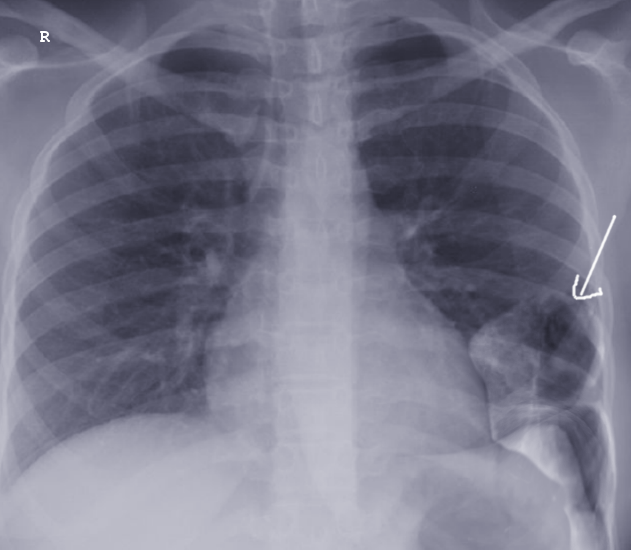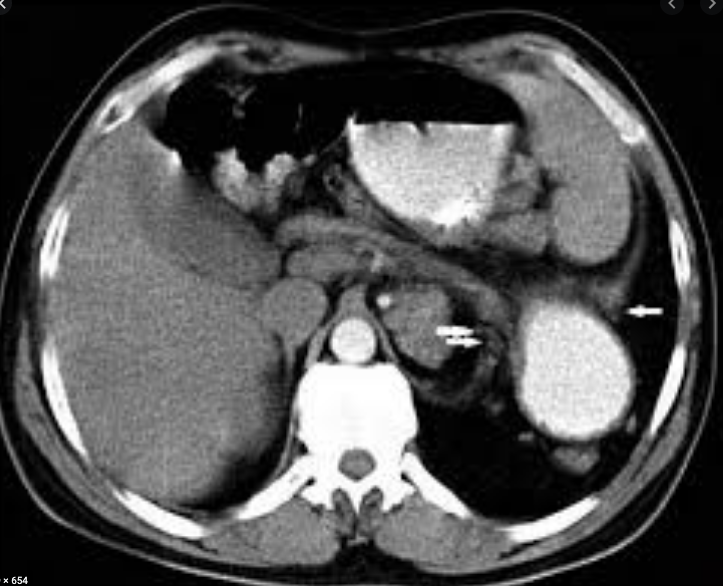[1]
Chandrasekharan PK, Rawat M, Madappa R, Rothstein DH, Lakshminrusimha S. Congenital Diaphragmatic hernia - a review. Maternal health, neonatology and perinatology. 2017:3():6. doi: 10.1186/s40748-017-0045-1. Epub 2017 Mar 11
[PubMed PMID: 28331629]
[2]
Katukuri GR, Madireddi J, Agarwal S, Kareem H, Devasia T. Delayed Diagnosis of Left-Sided Diaphragmatic Hernia in an Elderly Adult with no History of Trauma. Journal of clinical and diagnostic research : JCDR. 2016 Apr:10(4):PD04-5. doi: 10.7860/JCDR/2016/17506.7544. Epub 2016 Apr 1
[PubMed PMID: 27190882]
[3]
Lu J, Wang B, Che X, Li X, Qiu G, He S, Fan L. Delayed traumatic diaphragmatic hernia: A case-series report and literature review. Medicine. 2016 Aug:95(32):e4362. doi: 10.1097/MD.0000000000004362. Epub
[PubMed PMID: 27512848]
Level 2 (mid-level) evidence
[4]
Díaz Candelas DA, de la Plaza Llamas R, Arteaga Peralta V, Ramia JM. Complicated diaphragmatic hernia. Cirugia espanola. 2020 Apr:98(4):238. doi: 10.1016/j.ciresp.2019.04.016. Epub 2019 Jun 1
[PubMed PMID: 31164215]
[6]
Bocchini G, Guida F, Sica G, Codella U, Scaglione M. Diaphragmatic injuries after blunt trauma: are they still a challenge? Reviewing CT findings and integrated imaging. Emergency radiology. 2012 Jun:19(3):225-35. doi: 10.1007/s10140-012-1025-4. Epub 2012 Feb 24
[PubMed PMID: 22362421]
[7]
Petrone P, Asensio JA, Marini CP. Diaphragmatic injuries and post-traumatic diaphragmatic hernias. Current problems in surgery. 2017 Jan:54(1):11-32. doi: 10.1067/j.cpsurg.2016.11.001. Epub 2016 Nov 29
[PubMed PMID: 28212818]
[8]
Pancholi CK, Hombalkar NN, Dalvi SB, Gurav PD. Left Sided Hydro-pneumothorax in a Operated Case of Left Diaphragmatic Hernia Repair: A Diagnostic Dilemma. Journal of clinical and diagnostic research : JCDR. 2015 Apr:9(4):PD03-4. doi: 10.7860/JCDR/2015/11879.5759. Epub 2015 Apr 1
[PubMed PMID: 26023591]
Level 3 (low-level) evidence
[9]
Kozak O, Mentes O, Harlak A, Yigit T, Kilbas Z, Aslan I, Akin M, Bozlar U. Late presentation of blunt right diaphragmatic rupture (hepatic hernia). The American journal of emergency medicine. 2008 Jun:26(5):638.e3-5. doi: 10.1016/j.ajem.2007.10.032. Epub
[PubMed PMID: 18534320]
[10]
Esposito F, Lim C, Salloum C, Osseis M, Lahat E, Compagnon P, Azoulay D. Diaphragmatic hernia following liver resection: case series and review of the literature. Annals of hepato-biliary-pancreatic surgery. 2017 Aug:21(3):114-121. doi: 10.14701/ahbps.2017.21.3.114. Epub 2017 Aug 31
[PubMed PMID: 28989997]
Level 2 (mid-level) evidence
[11]
Cortes M, Tapuria N, Khorsandi SE, Ibars EP, Vilca-Melendez H, Rela M, Heaton ND. Diaphragmatic hernia after liver transplantation in children: case series and review of the literature. Liver transplantation : official publication of the American Association for the Study of Liver Diseases and the International Liver Transplantation Society. 2014 Dec:20(12):1429-35. doi: 10.1002/lt.23977. Epub 2014 Nov 5
[PubMed PMID: 25124299]
Level 2 (mid-level) evidence
[12]
Sommese K, Kelley K, Tan B, Fontana M, Brooks J. Iatrogenic Incarcerated Diaphragmatic Hernia after Nissen Fundoplication. The American surgeon. 2018 Jul 1:84(7):1195-1196
[PubMed PMID: 30064587]
[13]
Blount AL, Craft RO, Harold KL, Roberts CC. Laparoscopic Repair of a Chronic Iatrogenic Diaphragmatic Hernia. Radiology case reports. 2009:4(3):304. doi: 10.2484/rcr.v4i3.304. Epub 2015 Dec 7
[PubMed PMID: 27307823]
Level 3 (low-level) evidence
[14]
Dell'Abate P, Bertocchi E, Dalla Valle R, Viani L, Del Rio P, Sianesi M. Iatrogenic diaphragmatic hernia following laparoscopic left colectomy for splenic flexure cancer An unusual complication. Annali italiani di chirurgia. 2016 Nov 3:87():. pii: S2239253X16025937. Epub 2016 Nov 3
[PubMed PMID: 28232645]
[15]
Vilallonga R, Caubet E, González O, Neff KJ, Fort JM, Mazarro A, Armengol M. Laparoscopic repair of a postadrenalectomy left-sided diaphragmatic hernia complicated by chronic colon obstruction. Surgical endoscopy. 2013 May:27(5):1826-8. doi: 10.1007/s00464-012-2641-5. Epub 2012 Dec 12
[PubMed PMID: 23233014]
[16]
Suh Y, Lee JH, Jeon H, Kim D, Kim W. Late onset iatrogenic diaphragmatic hernia after laparoscopy-assisted total gastrectomy for gastric cancer. Journal of gastric cancer. 2012 Mar:12(1):49-52. doi: 10.5230/jgc.2012.12.1.49. Epub 2012 Mar 30
[PubMed PMID: 22500265]
[17]
Fukami T, Konoeda C, Kitano K, Sakamoto M, Sano A, Yoshida Y, Mura T, Nakajima J. [Iatrogenic diaphragmatic hernia following partial resection of the lung via video-assisted thoracoscopy]. Kyobu geka. The Japanese journal of thoracic surgery. 2010 Dec:63(13):1151-4
[PubMed PMID: 21174666]
[18]
Mínguez Ruiz G, García Florez LJ, Arias Pacheco RD, García Bear I, Ramos Pérez V, Pire Abaitua G. Post-nephrectomy diaphragmatic hernia. Increase suspicion and decrease morbi-mortality: two cases report. Journal of surgical case reports. 2018 Aug:2018(8):rjy224. doi: 10.1093/jscr/rjy224. Epub 2018 Aug 20
[PubMed PMID: 30151114]
Level 3 (low-level) evidence
[19]
Singh M, Singh G, Pandey A, Cha CH, Kulkarni S. Laparoscopic repair of iatrogenic diaphragmatic hernia following radiofrequency ablation for hepatocellular carcinoma. Hepatology research : the official journal of the Japan Society of Hepatology. 2011 Nov:41(11):1132-6. doi: 10.1111/j.1872-034X.2011.00865.x. Epub
[PubMed PMID: 22032681]
[20]
Sano A, Kato H, Hamatani H, Sakai M, Tanaka N, Inose T, Kimura H, Kuwano H. Diaphragmatic hernia with ischemic bowel obstruction in pregnancy: report of a case. Surgery today. 2008:38(9):836-40. doi: 10.1007/s00595-007-3718-y. Epub 2008 Aug 28
[PubMed PMID: 18751950]
Level 3 (low-level) evidence
[21]
Jacobs R, Honore PM, Hosseinpour N, Nieboer K, Spapen HD. Sudden cardiac arrest during pregnancy: a rare complication of acquired maternal diaphragmatic hernia. Acta clinica Belgica. 2012 May-Jun:67(3):198-200
[PubMed PMID: 22897068]
[22]
Fair KA, Gordon NT, Barbosa RR, Rowell SE, Watters JM, Schreiber MA. Traumatic diaphragmatic injury in the American College of Surgeons National Trauma Data Bank: a new examination of a rare diagnosis. American journal of surgery. 2015 May:209(5):864-8; discussion 868-9. doi: 10.1016/j.amjsurg.2014.12.023. Epub 2015 Feb 21
[PubMed PMID: 25952278]
[23]
Testini M, Girardi A, Isernia RM, De Palma A, Catalano G, Pezzolla A, Gurrado A. Emergency surgery due to diaphragmatic hernia: case series and review. World journal of emergency surgery : WJES. 2017:12():23. doi: 10.1186/s13017-017-0134-5. Epub 2017 May 18
[PubMed PMID: 28529538]
Level 2 (mid-level) evidence
[24]
Lodhia JV, Appiah S, Tcherveniakov P, Krysiak P. Diaphragmatic hernia masquerading as a pulmonary metastasis. Annals of the Royal College of Surgeons of England. 2015 Mar:97(2):e27-9. doi: 10.1308/003588414X14055925060758. Epub
[PubMed PMID: 25723679]
[25]
Nason LK, Walker CM, McNeeley MF, Burivong W, Fligner CL, Godwin JD. Imaging of the diaphragm: anatomy and function. Radiographics : a review publication of the Radiological Society of North America, Inc. 2012 Mar-Apr:32(2):E51-70. doi: 10.1148/rg.322115127. Epub
[PubMed PMID: 22411950]
[26]
Beshay M, Mertzlufft F, Kottkamp HW, Reymond M, Schmid RA, Branscheid D, Vordemvenne T. Analysis of risk factors in thoracic trauma patients with a comparison of a modern trauma centre: a mono-centre study. World journal of emergency surgery : WJES. 2020 Jul 31:15(1):45. doi: 10.1186/s13017-020-00324-1. Epub 2020 Jul 31
[PubMed PMID: 32736642]
[29]
Chatterjee D, Ing RJ, Gien J. Update on Congenital Diaphragmatic Hernia. Anesthesia and analgesia. 2020 Sep:131(3):808-821. doi: 10.1213/ANE.0000000000004324. Epub
[PubMed PMID: 31335403]
[30]
Tibrewala NS, Pai PM. Congenital malformations in the newborn period. Indian pediatrics. 1974 Jun:11(6):403-7
[PubMed PMID: 4473425]
[31]
Panda A, Kumar A, Gamanagatti S, Patil A, Kumar S, Gupta A. Traumatic diaphragmatic injury: a review of CT signs and the difference between blunt and penetrating injury. Diagnostic and interventional radiology (Ankara, Turkey). 2014 Mar-Apr:20(2):121-8. doi: 10.5152/dir.2013.13248. Epub
[PubMed PMID: 24412818]
[32]
Zahid A, Nawaz FA, Duvuru R, Alabrach YS, Ahmed A. Congenital Diaphragmatic Hernia With Kidney and Spleen Herniation in the United Arab Emirates: A Case Report. Cureus. 2022 Jul:14(7):e26732. doi: 10.7759/cureus.26732. Epub 2022 Jul 11
[PubMed PMID: 35967164]
Level 3 (low-level) evidence
[33]
Mbaye PA, Gueye D, Fall M, Zeng FTA, Seye C, Seck NF, Cissé L, Ndoye NA, Sagna A, Ngom G. [Management of congenital diaphragmatic hernia in sub-Saharan Africa: experience in the Albert Royer National Children's Hospital Center, Senegal]. The Pan African medical journal. 2022:41():185. doi: 10.11604/pamj.2022.41.185.30907. Epub 2022 Mar 8
[PubMed PMID: 35655674]
[34]
Pelizzo G, Finazzo F, Vitaliti MS, Bellieni CV, Calcaterra V. Left-sided congenital diaphragmatic hernia and liver-up: time to revise simplistic views? The journal of maternal-fetal & neonatal medicine : the official journal of the European Association of Perinatal Medicine, the Federation of Asia and Oceania Perinatal Societies, the International Society of Perinatal Obstetricians. 2021 Dec:34(23):4005-4007. doi: 10.1080/14767058.2019.1702948. Epub 2019 Dec 25
[PubMed PMID: 31875733]
[35]
Iqbal CW, Derderian SC, Lusk L, Basta A, Filly RA, Lee H, Hirose S. Outcomes for Prenatally Diagnosed Right Congenital Diaphragmatic Hernia. Fetal diagnosis and therapy. 2020:47(1):1-6. doi: 10.1159/000369385. Epub 2015 Mar 4
[PubMed PMID: 25765922]
[36]
Aprahamian A, Nouyrigat V, Grévent D, Hervieux E, Chéron G. [Postnatal diagnosis of gastric volvulus revealing congenital diaphragmatic hernia]. Archives de pediatrie : organe officiel de la Societe francaise de pediatrie. 2017 May:24(5):464-467. doi: 10.1016/j.arcped.2017.02.028. Epub 2017 Mar 21
[PubMed PMID: 28336004]
[37]
Chang PT, Taylor GA. Umbilical venous catheter malposition and errors in interpretation in newborns with Bochdalek hernia. Pediatric radiology. 2015 Jul:45(7):982-8. doi: 10.1007/s00247-014-3275-7. Epub 2015 Feb 10
[PubMed PMID: 25875634]
[38]
Lynch T, Kilgar J, Al Shibli A. Pediatric Abdominal Trauma. Current pediatric reviews. 2018:14(1):59-63. doi: 10.2174/1573396313666170815100547. Epub
[PubMed PMID: 28814248]
[39]
Şentürk M, Çakır M, Ali Akbulut M, Yeşildağ K. Approach to Traumatic Diaphragm Injuries: Single Center Experience. Journal of acute medicine. 2021 Mar 1:11(1):18-21. doi: 10.6705/j.jacme.202103_11(1).0003. Epub
[PubMed PMID: 33928012]
[40]
Abboud NM, Rimbault M, Abboud S, El Nakadi I, Charara FG. A Surgical Alternative in the Treatment of Recurrent Diaphragmatic Hernia after Total Gastrectomy. Plastic and reconstructive surgery. Global open. 2020 Dec:8(12):e3302. doi: 10.1097/GOX.0000000000003302. Epub 2020 Dec 21
[PubMed PMID: 33425611]
[41]
Reddy M, Kroushev A, Palmer K. Undiagnosed maternal diaphragmatic hernia - a management dilemma. BMC pregnancy and childbirth. 2018 Jun 15:18(1):237. doi: 10.1186/s12884-018-1864-4. Epub 2018 Jun 15
[PubMed PMID: 29907140]
[42]
Thompson M, Wills S, Byard RW. Forensic Features of Lethal Late-Presenting Diaphragmatic Hernias. Journal of forensic sciences. 2016 Sep:61(5):1261-5. doi: 10.1111/1556-4029.13142. Epub 2016 Jun 22
[PubMed PMID: 27329694]
[43]
D'Orio V, Demondion P, Lebreton G, Coutance G, Varnous S, Leprince P. Acquired transdiaphragmatic hernia: an unusual cause of cardiac tamponade. Asian cardiovascular & thoracic annals. 2017 Mar:25(3):233-236. doi: 10.1177/0218492317698326. Epub 2017 Jan 1
[PubMed PMID: 28325075]



